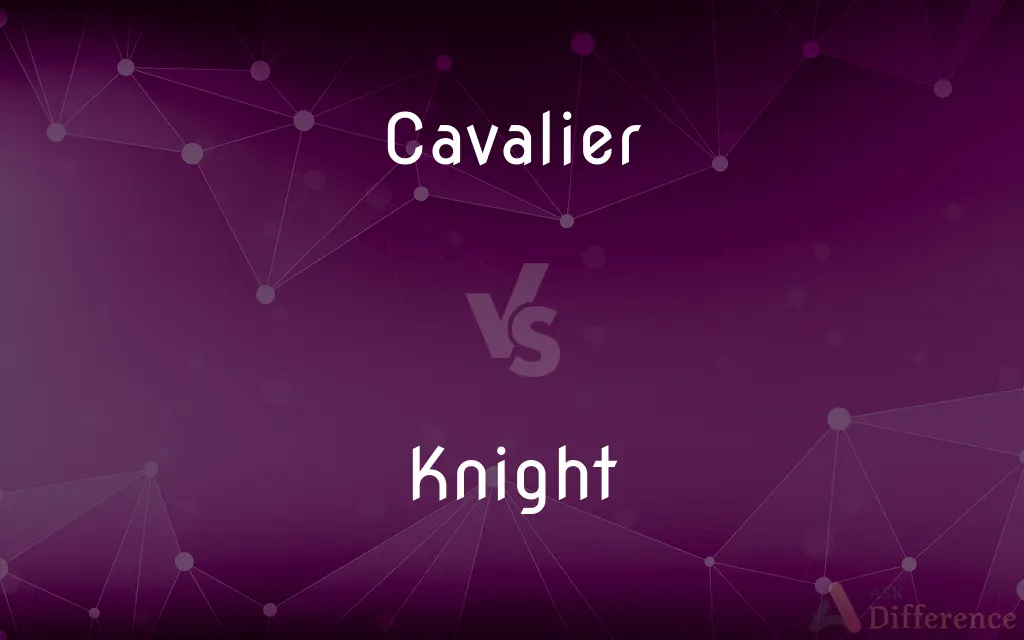Cavalier vs. Knight — What's the Difference?
Edited by Tayyaba Rehman — By Maham Liaqat — Updated on March 8, 2024
A cavalier is associated with a dashing or carefree attitude, often linked to the supporters of Charles I during the English Civil War, whereas a knight is a medieval warrior of high rank, bound by codes of chivalry.

Difference Between Cavalier and Knight
Table of Contents
ADVERTISEMENT
Key Differences
Cavaliers were part of the Royalist party during the 17th-century English Civil War, known for their loyalty to Charles I and their distinctive fashionable attire, reflecting a lifestyle of elegance and a carefree attitude. Knights, on the other hand, were mounted warriors in medieval Europe, bestowed with titles of honor by a monarch or other political leader for military service, often coming from the nobility and adhering to the chivalric code, which included values like bravery, courtesy, and honor in battle.
The term cavalier has evolved to describe someone with a nonchalant or dashing attitude, often detached from or indifferent to the seriousness of a situation. This contrasts with the knight’s image, which symbolizes duty, honor, and a sense of responsibility, deeply embedded in the historical context of protecting the realm and serving justice. While cavaliers are often romanticized for their flamboyant lifestyle and loyalty to their cause, knights are celebrated for their valor, discipline, and commitment to higher ideals.
Cavaliers and knights both occupy prominent places in history and literature, embodying the ideals and values of their times. However, their roles and perceptions are shaped by distinct historical contexts. Cavaliers are particularly remembered for their role in the political and military struggle of the English Civil War and their allegiance to the monarchy, whereas knights are integral to the feudal systems of medieval Europe, serving as both military elite and social pillars in a highly stratified society.
In terms of attire and symbolism, cavaliers are often depicted with plumed hats, long flowing hair, and elaborate clothing, highlighting their association with aristocracy, courtly love, and the arts. Knights are typically represented in armor, with heraldic symbols and weapons like swords and shields, emphasizing their martial role and commitment to chivalry. This distinction reflects the broader cultural and temporal differences between the cavalier as a social and political figure and the knight as a military and chivalric ideal.
Despite these differences, both cavaliers and knights have left a lasting impact on popular culture and historical narrative, symbolizing the complexity of loyalty, honor, and identity. Their legacies continue to inspire stories, films, and discussions about the nature of bravery, individualism, and the pursuit of ideals.
ADVERTISEMENT
Comparison Chart
Historical Context
English Civil War (17th century).
Medieval Europe, feudal system.
Role
Supporter of Charles I, associated with nobility and fashion.
Mounted warrior, served a monarch, bound by chivalry.
Symbolism
Nonchalance, elegance, loyalty to monarchy.
Duty, honor, bravery, protection of the realm.
Attire
Plumed hats, long hair, elegant clothing.
Armor, heraldic symbols, weapons like swords and shields.
Values
Loyalty to the crown, carefree attitude, courtliness.
Chivalry, service, honor, justice, bravery.
Compare with Definitions
Cavalier
Pertaining to an aristocratic or refined manner, especially in dress and behavior.
The actor’s cavalier style captivated audiences, both on and off the screen.
Knight
Representing ideals of valor, loyalty, and service in medieval and Renaissance literature.
In Arthurian legends, knights embarked on quests in search of the Holy Grail.
Cavalier
A supporter of King Charles I in the English Civil War; associated with loyalty to the monarchy.
The cavaliers rallied to the king’s side, ready to fight for the monarchy.
Knight
Characterized by the wearing of armor and bearing of arms in the service of a lord or monarch.
Clad in shining armor, the knight rode into battle, his banner flying high.
Cavalier
Relating to or characteristic of the cavalier party or its members.
The cavalier poetry of the 17th century celebrated the courtly and the sensual.
Knight
Someone granted an honorary title of knighthood by a monarch or other leader for service to the country or monarch.
For his bravery in battle, the soldier was knighted by the queen.
Cavalier
Symbolizing the romanticized noble or royalist cause in historical narratives.
The novel portrayed the cavaliers in a light of romantic rebellion.
Knight
A mounted warrior of the medieval period, often of noble birth, who followed the code of chivalry.
The knight pledged his allegiance to the king, vowing to uphold the chivalric code.
Cavalier
Someone with a dashing or carefree attitude, often indifferent to serious matters.
His cavalier approach to life made him popular yet unpredictable.
Knight
A figure in European history known for participating in tournaments and quests.
Knights jousted at tournaments to display their skill and win honor.
Cavalier
Cavalier () was first used by Roundheads as a term of abuse for the wealthier royalist supporters of King Charles I and his son Charles II of England during the English Civil War, the Interregnum, and the Restoration (1642 – c. 1679). It was later adopted by the Royalists themselves.
Knight
A knight is a person granted an honorary title of knighthood by a head of state (including the pope) or representative for service to the monarch, the church or the country, especially in a military capacity.Knighthood finds origins in the Greek hippeis and hoplite (ἱππεῖς) and Roman eques and centurion of classical antiquity.In the Early Middle Ages in Europe, knighthood was conferred upon mounted warriors. During the High Middle Ages, knighthood was considered a class of lower nobility.
Cavalier
A supporter of King Charles I in the English Civil War.
Knight
A medieval tenant giving military service as a mounted man-at-arms to a feudal landholder.
Cavalier
A small spaniel of a breed with a long snout.
Knight
A medieval gentleman-soldier, usually high-born, raised by a sovereign to privileged military status after training as a page and squire.
Cavalier
Showing a lack of proper concern; offhand
Anne was irritated by his cavalier attitude
Knight
A man holding a nonhereditary title conferred by a sovereign in recognition of personal merit or service to the country.
Cavalier
A gallant or chivalrous man, especially one serving as escort to a woman of high social position; a gentleman.
Knight
A man belonging to an order or brotherhood.
Cavalier
A mounted soldier; a knight.
Knight
A defender, champion, or zealous upholder of a cause or principle.
Cavalier
Cavalier A supporter of Charles I of England in his struggles against Parliament. Also called Royalist.
Knight
The devoted champion of a lady.
Cavalier
Showing arrogant or offhand disregard; dismissive
A cavalier attitude toward the suffering of others.
Knight
Abbr. Kt or N(Games) A chess piece, usually in the shape of a horse's head, that can be moved two squares along a rank and one along a file or two squares along a file and one along a rank. The knight is the only piece that can jump other pieces to land on an open square.
Cavalier
Carefree and nonchalant; jaunty.
Knight
To raise (a person) to knighthood.
Cavalier
Cavalier Of or relating to a group of 17th-century English poets associated with the court of Charles I.
Knight
(historical) A young servant or follower; a trained military attendant in service of a lord.
Cavalier
Not caring enough about something important.
Knight
(historical) A minor nobleman with an honourable military rank who had served as a page and squire.
Cavalier
High-spirited.
Knight
(by extension) An armored and mounted warrior of the Middle Ages.
King Arthur and the Knights of the Round Table
Cavalier
Supercilious.
Knight
A person obliged to provide knight service in exchange for maintenance of an estate held in knight's fee.
Cavalier
(historical) Of or pertaining to the party of King Charles I of England (1600–1649).
Knight
(modern) A person on whom a knighthood has been conferred by a monarch.
Cavalier
A military man serving on horse, early modern cavalry officers who had abandoned the heavy armor of medieval knights.
Knight
(literary) A brave, chivalrous and honorable man devoted to a noble cause or love interest.
Cavalier
A gallant: a sprightly young dashing military man.
Knight
(chess) A chess piece, often in the shape of a horse's head, that is moved two squares in one direction and one at right angles to that direction in a single move, leaping over any intervening pieces.
Cavalier
A gentleman of the class of such officers, particularly:
Knight
A playing card bearing the figure of a knight; the knave or jack.
Cavalier
A courtesan or noble under Charles I of England, particularly a royalist partisan during the English Civil War which ended his reign.
Knight
(entomology) Any of various nymphalid butterflies of the genus Ypthima.
Cavalier
A defensive work rising from a bastion, etc., and overlooking the surrounding area.
Knight
(modern) Any mushroom belonging to genus Tricholoma.
Cavalier
A Cavalier King Charles Spaniel, a small breed of spaniel of English origin with a silky, smooth coat and commonly a smooth undocked tail.
Knight
(transitive) To confer knighthood upon.
The king knighted the young squire.
Cavalier
Of a man: to act in a gallant and dashing manner toward (women).
Knight
To promote (a pawn) to a knight.
Cavalier
A military man serving on horseback; a knight.
Knight
A young servant or follower; a military attendant.
Cavalier
A gay, sprightly, military man; hence, a gallant.
Knight
In feudal times, a man-at-arms serving on horseback and admitted to a certain military rank with special ceremonies, including an oath to protect the distressed, maintain the right, and live a stainless life.
Knights, by their oaths, should right poor ladies' harms.
Cavalier
One of the court party in the time of king Charles I. as contrasted with a Roundhead or an adherent of Parliament.
Knight
A piece used in the game of chess, usually bearing a horse's head.
Cavalier
A work of more than ordinary height, rising from the level ground of a bastion, etc., and overlooking surrounding parts.
Knight
A playing card bearing the figure of a knight; the knave or jack.
Cavalier
Offhand; unceremonious; gay; easy; frank. Opposed to serious.
The plodding, persevering scupulous accuracy of the one, and the easy, cavalier, verbal fluency of the other, form a complete contrast.
Knight
To dub or create (one) a knight; - done in England by the sovereign only, who taps the kneeling candidate with a sword, saying: Rise, Sir --.
A soldier, by the honor-giving handOf CŒur-de-Lion knighted in the field.
Cavalier
High-spirited.
Knight
Originally a person of noble birth trained to arms and chivalry; today in Great Britain a person honored by the sovereign for personal merit
Cavalier
Supercilious; haughty; disdainful; curt; brusque.
Knight
A chessman in the shape of a horse's head; can move two squares horizontally and one vertically (or vice versa)
Cavalier
Of or pertaining to the party of King Charles I.
Knight
Raise (someone) to knighthood;
The Beatles were knighted
Cavalier
A gallant or courtly gentleman
Cavalier
A royalist supporter of Charles I during the English Civil War
Cavalier
Given to haughty disregard of others
Common Curiosities
How did knights acquire their status?
Knights were typically of noble birth and trained from youth for military service, later being formally knighted in a ceremony that recognized their skill and valor.
What were the key characteristics of a medieval knight?
Key characteristics included noble birth, military skill, adherence to the chivalric code, and service to a lord or monarch as a mounted warrior.
Can the term "cavalier" be used in a modern context?
Yes, "cavalier" can describe someone with a nonchalant or dismissive attitude in contemporary language, beyond its historical political affiliation.
What is the legacy of cavaliers in modern culture?
Cavaliers are often romanticized in literature and film as symbols of loyalty, elegance, and the royalist cause, reflecting broader themes of conflict and identity.
Did cavaliers and knights follow the same code of behavior?
Cavaliers and knights adhered to different codes reflective of their times; knights followed chivalry, emphasizing valor and honor, while cavaliers, though also valuing bravery and loyalty, are more noted for their association with the courtly and the fashionable.
What defined a cavalier during the English Civil War?
A cavalier was defined by loyalty to King Charles I, often coming from the nobility or gentry, and known for a distinctive, fashionable appearance and a carefree lifestyle.
How did one become a cavalier?
Becoming a cavalier was more about political affiliation and support for King Charles I during the English Civil War than about birth or a formal ceremony, unlike knighthood.
What role did knights and cavaliers play in their respective wars?
Knights served as heavily armored cavalry and leaders in medieval conflicts, while cavaliers were part of the royalist forces fighting against Parliamentarians in the English Civil War.
How are the concepts of cavaliers and knights reflected in today’s society?
The concepts manifest in cultural representations like literature, movies, and ceremonies that honor chivalric values or the spirit of loyalty and elegance associated with cavaliers, adapting historical ideals to contemporary contexts.
Are there modern equivalents to knights?
While the specific social and military role of knights does not have a direct modern equivalent, the concept of knighthood exists as a ceremonial honor in many countries, recognizing contributions to society or the state.
Share Your Discovery

Previous Comparison
Hon vs. Honey
Next Comparison
Bolognese vs. LasagnaAuthor Spotlight
Written by
Maham LiaqatEdited by
Tayyaba RehmanTayyaba Rehman is a distinguished writer, currently serving as a primary contributor to askdifference.com. As a researcher in semantics and etymology, Tayyaba's passion for the complexity of languages and their distinctions has found a perfect home on the platform. Tayyaba delves into the intricacies of language, distinguishing between commonly confused words and phrases, thereby providing clarity for readers worldwide.
















































